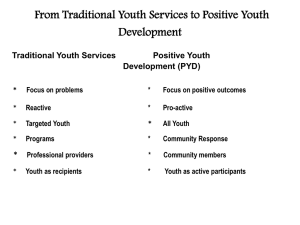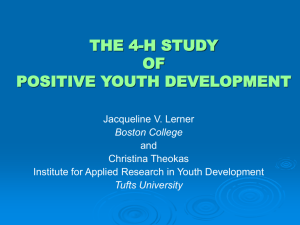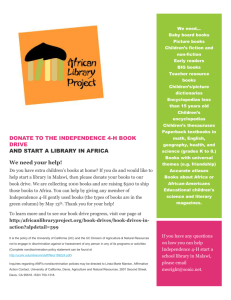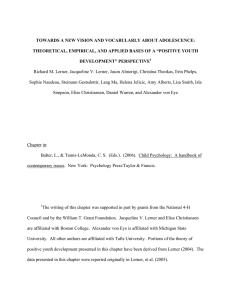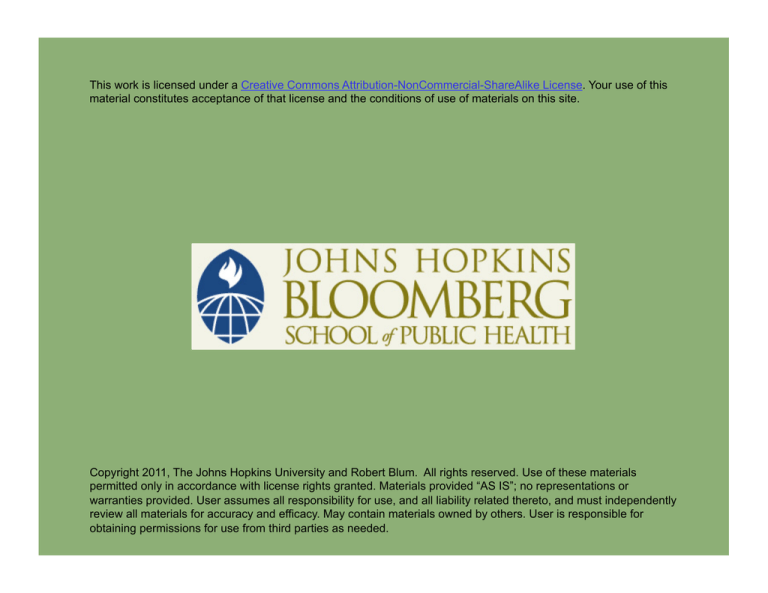
This work is licensed under a Creative Commons Attribution-NonCommercial-ShareAlike License. Your use of this
material constitutes acceptance of that license and the conditions of use of materials on this site.
Copyright 2011, The Johns Hopkins University and Robert Blum. All rights reserved. Use of these materials
permitted only in accordance with license rights granted. Materials provided “AS IS”; no representations or
warranties provided. User assumes all responsibility for use, and all liability related thereto, and must independently
review all materials for accuracy and efficacy. May contain materials owned by others. User is responsible for
obtaining permissions for use from third parties as needed.
Section F
The Emergence of the Positive Youth Development (PYD)
Perspective
The Emergence of the PYD Perspective
Replacing the deficit view of adolescence, the PYD perspective
offers a new, strength-based vision for—and vocabulary about—
youth
By virtue of the enormous capacity for systematic change
(plasticity) during adolescence, the PYD perspective sees all
adolescents as having strengths and speaks of greater well-being
and thriving as possible for all youth
The “five Cs”—competence, confidence, character, caring, and
connection—have been hypothesized as a way of conceptualizing
PYD (and of integrating all the separate indicators of it, such as
academic achievement or self esteem)
3
Foundations of the PYD Perspective
Derived from a developmental science approach to description,
explanation, and optimization that is informed by developmental
systems models
Derived from evolutionary biological (e.g., Gould, Lewontin) and
comparative psychological (e.g., Schneirla, Tobach, Gottlieb,
Greenberg, Suomi) theory and data about plasticity and adaptive
developmental regulations (mutually beneficial individual
context relations)
Derived from formal (reviews of evaluation research; by Blum and
by Roth and Brooks-Gunn) and informal (practitioner report)
assessments of the efficacy of youth development programs
4
Key Principles of the PYD Perspective
Because of the potential to change, all youths have strengths
All contexts have strengths as well
- These strengths are resources that may be used to promote
positive youth development
These resources are termed “developmental assets”
- They are the “social nutrients” needed for healthy development
5
Key Principles of the PYD Perspective
These assets are found in families, schools, faith institutions, youth
serving organizations, and the community more generally
If the strengths of youth are combined with ecological
developmental assets, then positive, healthy development may
occur
We may be optimistic that it is in our power to promote positive
development among all youth
6
Using the PYD Perspective to Study Adolescent Development
The 4-H study of positive youth development
7
Design of the 4-H Study
The 4-H study is a longitudinal investigation
Beginning in the 5th grade, we are following some youth through
12th grade (and we hope for at least one year past high school)
To adjust for attrition, to maintain power, and to hone in on the
nature of 4-H participation we have added new students in 6th, 7th,
8th grades, etc.
8
Design of the 4-H Study
We are longitudinally studying these new students as well
To date, we have sampled more than 4,000 youth and more than
2,000 parents from 25 states
9
4-H Study
Both the initial findings of the 4-H study and the more recent
findings, have changed research and practice in youth development
10
Five Initial Discoveries of the 4-H Study
1. We can now talk about the strengths of young people by using a
scientifically-validated set of positive terms:
-
PYD is constituted by “five Cs,” and PYD is linked to youth
contribution
11
PYD Is Constituted by “Five Cs”
PYD is constituted by “five Cs” and PYD continues to be linked to
youth contribution in grade 8
12
Five Initial Discoveries of the 4-H Study
2. We know now what must be done to promote PYD and contribution
- Across adolescence, positive youth development occurs when
the strengths of young people are aligned with the ecological
resources for healthy development present in their communities
- Youth strengths + ecological resources = “developmental assets”
13
Five Initial Discoveries of the 4-H Study
3. The strengths of young people—their internal developmental assets
—can be measured by three (3) characteristics:
-
-
-
Selection of goals
Optimization (developing strategies and means for reaching
one’s goals)
Compensation (in the face of failure or blocked goals)
14
Five Initial Discoveries of the 4-H Study
4. There are four ecological assets present in the families, schools,
and communities of youth:
-
-
-
-
-
Individuals
Institutions
Collective action
Access
In each setting INDIVIDUALS are always the most important
asset!
15
Five Initial Discoveries of the 4-H Study
5. Youth development (YD) programs constitute key ecological assets
promoting PYD
-
YD programs are effective in promoting PYD because they are
marked by the presence of the “big three,” that is . . .
1. Sustained, positive adult-youth relations
2. Skill building activities
3. Youth participation and leadership
16
Summary of Key Initial Discoveries of the 4-H Study
17

